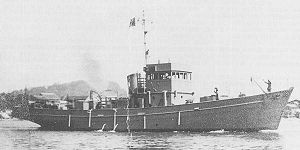- No.1 class auxiliary submarine chaser
-

No.1 class on 10 January 1945Class overview Name: No.1-class auxiliary submarine chaser Builders: Hull
Ichikawa Shipyard
Gōriki Shipyard
Koyanagi Shipyard
Saga Iron Works
Shikoku Dock Company
Jinen Iron Works
Tokushima Limited Sipyard
Nishii Shipyard
Hayashikane Heavy Industries
Fukuoka Iron Works
Fukushima Iron Works
Funaya Iron Works
Miho Shipyard
Murakami Shipyard
Yamanishi Iron Works
Yonago Shipyard
Fitted with armaments
Kure Naval Arsenal
Maizuru Naval Arsenal
Sasebo Naval Arsenal
Yokosuka Naval ArsenalOperators:  Imperial Japanese Navy
Imperial Japanese Navy
 Japan Maritime Safety Agency
Japan Maritime Safety Agency
 Japan Coastal Safety Force (later Japan Maritime Self-Defence Force)
Japan Coastal Safety Force (later Japan Maritime Self-Defence Force)
 Government of Japan
Government of Japan
 Republic of China Navy
Republic of China Navy
 People's Liberation Army Navy
People's Liberation Army NavyBuilt: 1942 (?)–1945 In commission: 1943–1971 Planned: 200 Completed: 200 Lost: 81 Retired: 119 General characteristics Type: Submarine chaser Displacement: 130 long tons (132 t) standard Length: 29.20 m (95 ft 10 in) overall Beam: 5.65 m (18 ft 6 in) Draught: 1.97 m (6 ft 6 in) Propulsion: 1 × intermediate diesel
shingle shaft, 400 bhpSpeed: 11.0 knots (12.7 mph; 20.4 km/h) Range: 1,000 nmi (1,900 km) at 10.0 kn (11.5 mph; 18.5 km/h) Complement: 32 Armament: • 1 × 7.7 mm machine gun
• 22 × depth charges
• 1 × dunking hydrophone
• 1 × simple sonarThe No.1 class auxiliary submarine chaser (第一号型駆潜特務艇, Dai Ichi Gō-gata Kusen-Tokumutei) was a class of submarine chasers of the Imperial Japanese Navy (IJN), serving during World War II. 200 vessels were built under the Maru Kyū Programme (Ship # 500–599) and the Maru Sen Programme (Ship # 2001–2100).
Background
- In 1939, the IJN wanted the point-defence subcahser for defence of their naval bases. In 1940, they built small prototype submarine chasers (No.1182 and No.1183) from a standard wooden fishing boat.
- The IJN made a try of them, and they confirmed that it was effective subchaser. In 1941, the IJN ordered 100 vessels.
- In the wartime, their performance were good. However, they were always troubled by insect damage, because their hull was wood.
- They who survived war played an active part for minesweeping of magnetic mines.
Ships in class
Maru Kyū Programme vessels. (Ship # 500–599)
- Aomori Prefecture on 21 April 1948.
- Ministry of Education on 29 May 1948.
- Maru Sen Programme vessels. (Ship # 2001–2100)
- Kanagawa Prefecture on 16 February 1948.
- No.2064 vessel (Aux. Submarine Chaser No.214), transferred to Karafuto Prefecture, before completed.
- edit] Bibliography
- Ships of the World special issue Vol.45, Escort Vessels of the Imperial Japanese Navy, Kaijinsha, (Japan), February 1996
- The Maru Special-Japanese Naval Vessels No.49, Japanese submarine chasers, Ushio Shobō (Japan), March 1981
Japanese auxiliary ship classes of World War IICargo ships Colliers and Oilers Ōtomari S
Landing ships No.1 · No.101 · Shinshū Maru S (Army) · SS (Army)
Minelayers and Cable layer Tokiwa SC · Itsukushima S · Yaeyama S · Okinoshima S · Tsugaru S · Minoo SC · Shirataka S · Hatsutaka · Tsubame · Natsushima (1933) · Sokuten (1938) · Hirashima · Ajiro S · Kamishima · Hashima · Sokuten (1913) · Aux. No.1 · Aux. No.101 (ex-HMS Barlight) SC
Minesweepers No.1 (1923) · No.5 (1928) · No.13 · No.17 · No.7 (1938) · No.19 · No.101 (ex-HMS Taitam and Waglan) C · Aux. No.1 · Aux. No.101 (ex-HNLMS DEFG class) · Aux. No.104 (ex-HNLMS DEFG class)
Patrol boats Seaplane tenders Submarine chasers
Survey ships Target ships Training ships Fuji SC · Shikishima SC · Asama SC · Azuma SC · Kasuga SC
S - Single ship of class • C - Converted to ship type • I - Incomplete until the end of war
Categories:- World War II naval ships of Japan
- Small combat vessel classes
- 1940s ships
Wikimedia Foundation. 2010.

